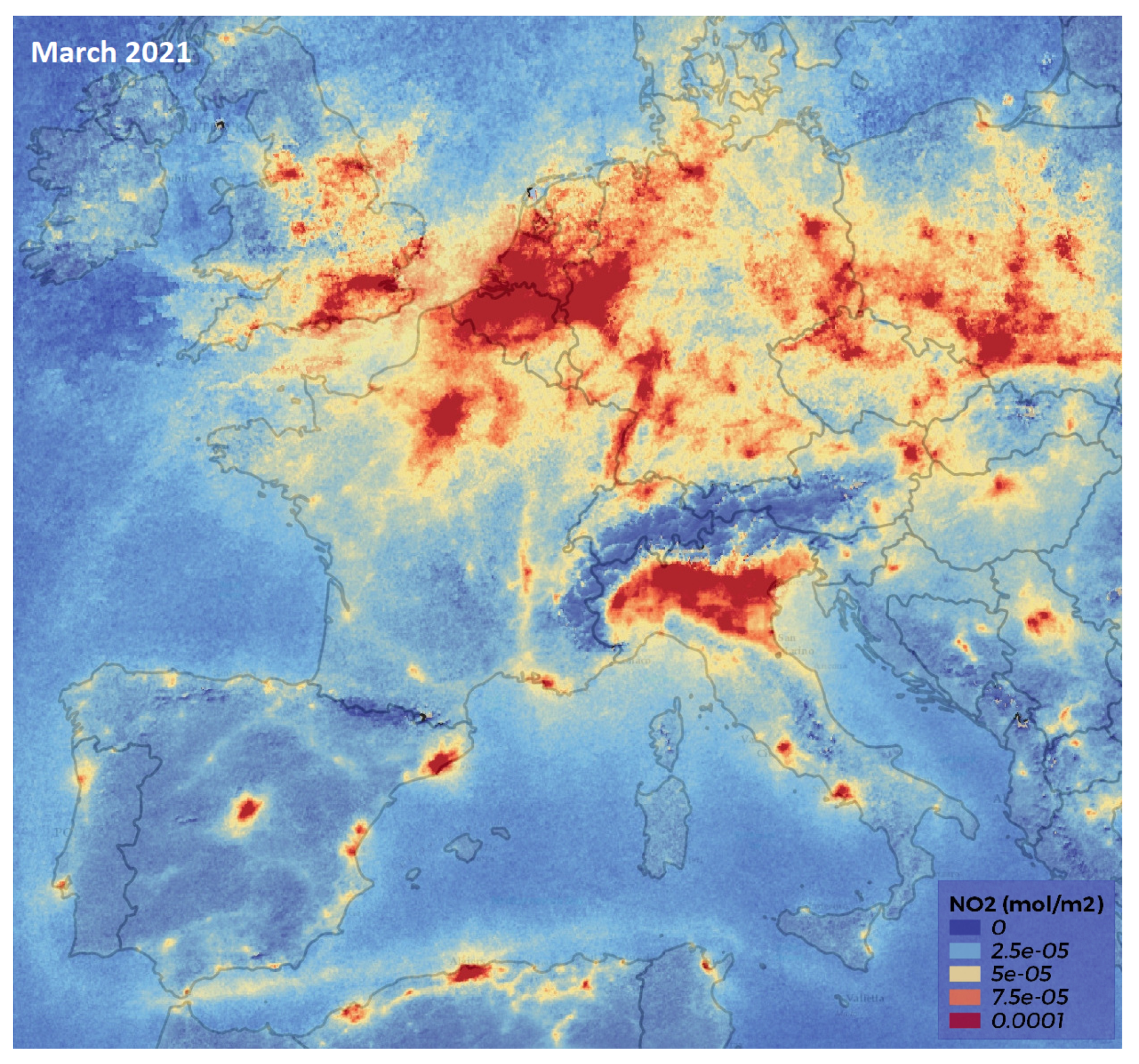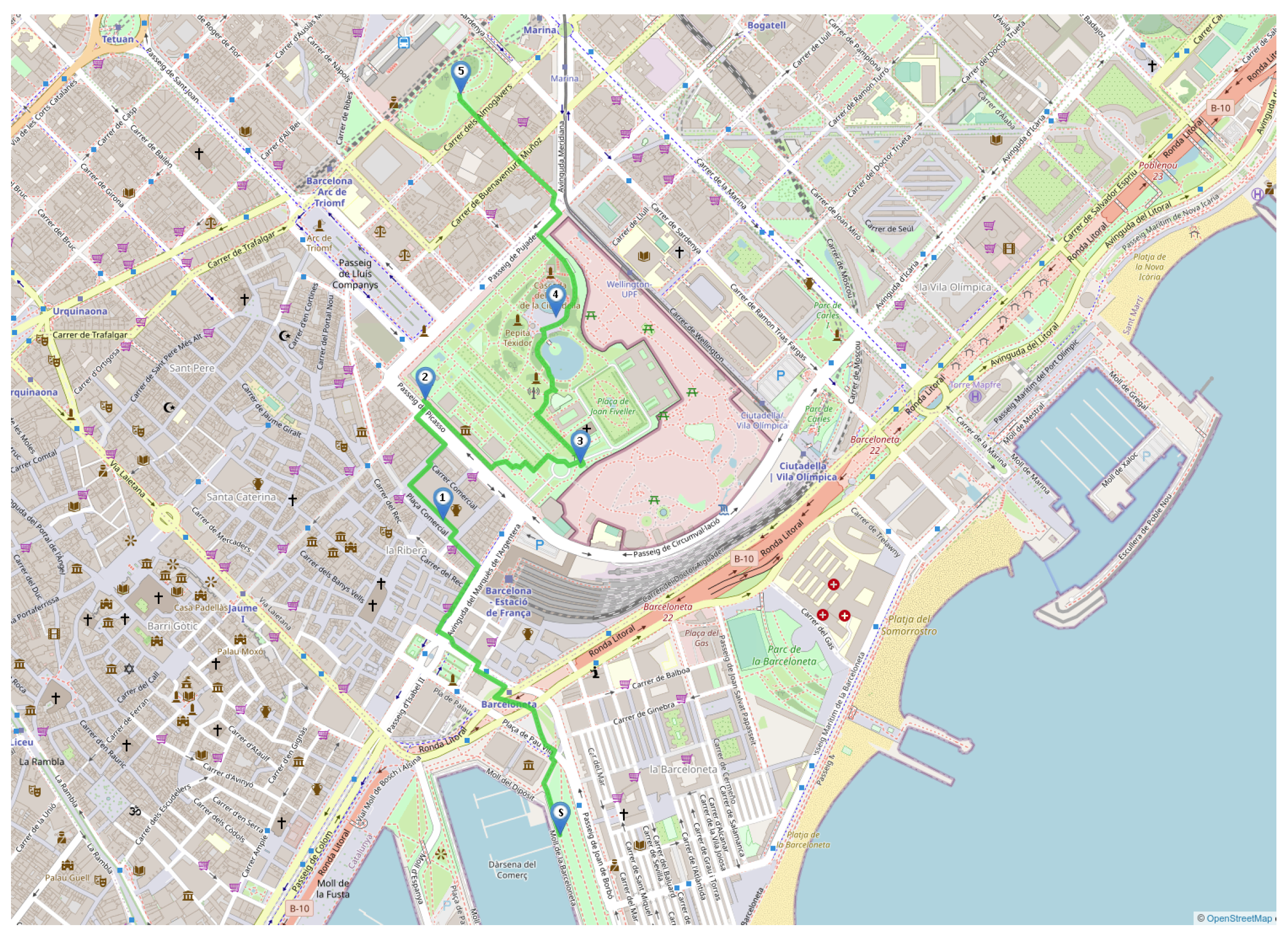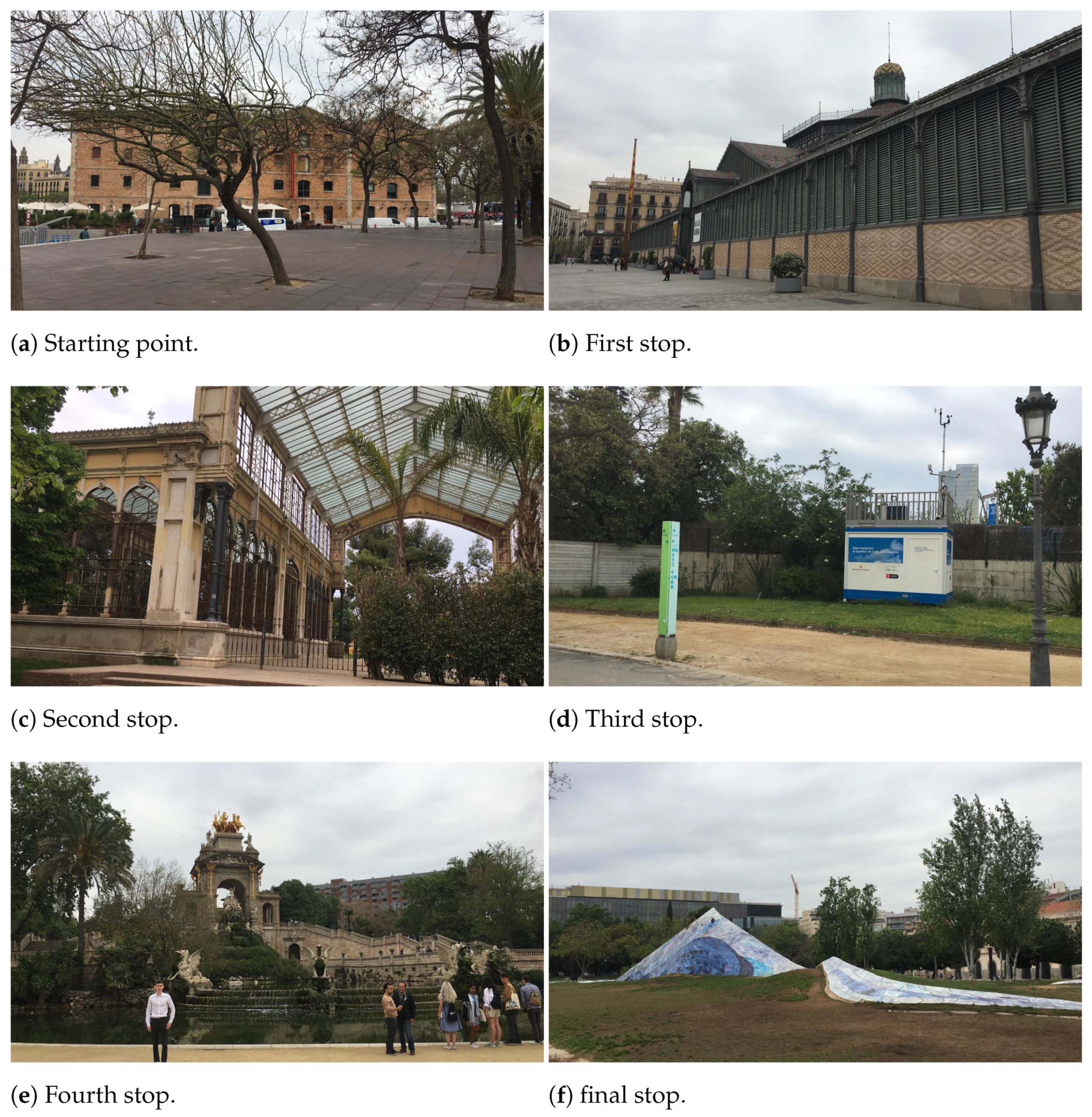Conscious Walk Methodology Design for Acoustic, Air Quality and Biodiversity Evaluation in Urban Environments †
Abstract
1. Introduction
- Soundscape: The soundscape is usually characterized by soundmarks. The perception is dominated by acoustic comfort. Nevertheless, soundscape descriptors have been used s well [6] in the development of predictive models of perceived affective quality.
- Air quality: air quality is measured by scientists using different approaches. First, the Copernicus European system provides maps with high coverage and 7 × 7 km spatial sampling all around Europe [7]. An example of a map can be seen in Figure 1. However, this resolution does not allow for the identification of air pollution at the level of different streets in a neighbourhood. The European Commission provides information on the current air quality situation based on measurements carried out at more than 2000 air quality measurement stations across Europe. In Spain, control and surveillance of air quality are carried out through networks maintained by the autonomous communities and local entities. Thus, national and regional authorities use maps generated from the interpolation of measurements acquired at reference stations located in relevant points of the territory, among others [8].
- Biodiversity: biodiversity is usually analyzed by biologists, who identify different species and characterize the different habitats that are present in the city. There are an increasing number of apps which allow citizens to identify species in a collaborative way, e.g., Inaturalist (https://www.inaturalist.org (accessed on 14 December 2022)).
2. Conscious Walk Description
3. Conscious Walk Design
3.1. Route Design
3.2. Evaluation of Stopping Points
4. Conclusions
Author Contributions
Funding
Institutional Review Board Statement
Informed Consent Statement
Data Availability Statement
Acknowledgments
Conflicts of Interest
Abbreviation
| WSP | World Soundscape Project |
References
- Hänninen, O.; Knol, A.B.; Jantunen, M.; Lim, T.A.; Conrad, A.; Rappolder, M.; Carrer, P.; Fanetti, A.C.; Kim, R.; Buekers, J.; et al. Environmental burden of disease in Europe: Assessing nine risk factors in six countries. Environ. Health Perspect. 2014, 122, 439. [Google Scholar] [CrossRef] [PubMed]
- Southwork, M.F. The Sonic Environment of Cities. Master’s Thesis, Massachusetts Institute of Technology, Cambridge, UK, 1967. [Google Scholar]
- Khomenko, S.; Cirach, M.; Pereira-Barboza, E.; Mueller, N.; Barrera-Gómez, J.; Rojas-Rueda, D.; de Hoogh, K.; Hoek, G.; Nieuwenhuijsen, M. Premature mortality due to air pollution in European cities: A health impact assessment. Lancet Planet. Health 2021, 5, E121–E134. [Google Scholar] [CrossRef] [PubMed]
- Mueller, N.; Rojas-Rueda, D.; Basagaña, X.; Cirach, M.; Cole-Hunter, T.; Dadvand, P.; Donaire-Gonzalez, D.; Foraster, M.; Gascon, M.; Martínez, D.; et al. Health impacts related to urban and transport planning: A burden of disease assessment. Environ. Int. 2017, 107, 243–257. [Google Scholar] [CrossRef] [PubMed]
- Springgay, S.; Truman, S.E. Walking Methodologies in a More-Than-Human World: WalkingLab; Routledge: London, UK, 2017. [Google Scholar]
- Aletta, F.; Kang, J.; Axelsson, Ö. Soundscape descriptors and a conceptual framework for developing predictive soundscape models. Landsc. Urban Plan. 2016, 149, 65–74. [Google Scholar] [CrossRef]
- ESA. Algorithm Theoretical Basis Document for the TROPOMI L01b Data Processor; No. 8.0. Report S5P-KNMI-L01B-0009-SD; The Royal Netherlands Meteorological Institute KNMI: De Bilt, The Netherlands, 2017. [Google Scholar]
- Jiménez, P.; Jorba, O.; Baldasano, J.; Gassó, S. The Use of a Modelling System as a Tool for Air Quality Management: Annual High-Resolution Simulations and Evaluation. Sci. Total Environ. 2008, 390, 323–340. [Google Scholar] [CrossRef] [PubMed]
- Schafer, R.M. Our Sonic Environment and the Soundscape: The Tuning of the World; Destiny Books: Rochester, VT, USA, 1977. [Google Scholar]
- Westerkamp, H. Soundwalking. Sound Herit. 1974, 3, 18–27. [Google Scholar]
- ISO/DIS 12913-2; 2018 Acoustics—Soundscape—Part 2: Data Collection and Reporting Requirements. International Organization for Standardization: Geneva, Switzerland, 2018.
- Garcia, D.; Parés, M.E. On the organization and validation of a pilot test of a mobile crowdsourced air quality monitoring system. Int. Arch. Photogramm. Remote Sens. Spat. Inf. Sci. 2021, XLIII-B4-2021, 361–366. [Google Scholar] [CrossRef]
- Aletta, F.; Kang, J. Soundscape approach integrating noise mapping techniques: A case study in Brighton, UK. Noise Mapp. 2015, 2, 1–12. [Google Scholar] [CrossRef]



Publisher’s Note: MDPI stays neutral with regard to jurisdictional claims in published maps and institutional affiliations. |
© 2022 by the authors. Licensee MDPI, Basel, Switzerland. This article is an open access article distributed under the terms and conditions of the Creative Commons Attribution (CC BY) license (https://creativecommons.org/licenses/by/4.0/).
Share and Cite
Arnela, M.; Ferrandiz-Rovira, M.; Freixes, M.; Garcia, D.; Martínez-Suquía, C.; Parés, M.E.; Serra, O.; Vidaña-Vila, E.; Alsina-Pagès, R.M. Conscious Walk Methodology Design for Acoustic, Air Quality and Biodiversity Evaluation in Urban Environments. Eng. Proc. 2022, 27, 75. https://doi.org/10.3390/ecsa-9-13336
Arnela M, Ferrandiz-Rovira M, Freixes M, Garcia D, Martínez-Suquía C, Parés ME, Serra O, Vidaña-Vila E, Alsina-Pagès RM. Conscious Walk Methodology Design for Acoustic, Air Quality and Biodiversity Evaluation in Urban Environments. Engineering Proceedings. 2022; 27(1):75. https://doi.org/10.3390/ecsa-9-13336
Chicago/Turabian StyleArnela, Marc, Mariona Ferrandiz-Rovira, Marc Freixes, Danielly Garcia, Carme Martínez-Suquía, Ma Eulàlia Parés, Oriol Serra, Ester Vidaña-Vila, and Rosa Ma Alsina-Pagès. 2022. "Conscious Walk Methodology Design for Acoustic, Air Quality and Biodiversity Evaluation in Urban Environments" Engineering Proceedings 27, no. 1: 75. https://doi.org/10.3390/ecsa-9-13336
APA StyleArnela, M., Ferrandiz-Rovira, M., Freixes, M., Garcia, D., Martínez-Suquía, C., Parés, M. E., Serra, O., Vidaña-Vila, E., & Alsina-Pagès, R. M. (2022). Conscious Walk Methodology Design for Acoustic, Air Quality and Biodiversity Evaluation in Urban Environments. Engineering Proceedings, 27(1), 75. https://doi.org/10.3390/ecsa-9-13336








